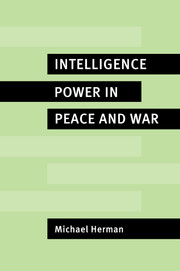Book contents
- Frontmatter
- Contents
- List of figures
- Preface and acknowledgements
- Glossary of terms and abbreviations
- Introduction
- I Evolution and outline
- II Components and boundaries
- 4 Collection sources
- 5 Collection characteristics
- 6 All-source analysis and assessment
- 7 Boundaries
- III Effects
- IV Accuracy
- V Evaluation and management
- VI The 1990s and beyond
- VII Summary
- Suggestions for further reading
- Index
4 - Collection sources
Published online by Cambridge University Press: 27 October 2009
- Frontmatter
- Contents
- List of figures
- Preface and acknowledgements
- Glossary of terms and abbreviations
- Introduction
- I Evolution and outline
- II Components and boundaries
- 4 Collection sources
- 5 Collection characteristics
- 6 All-source analysis and assessment
- 7 Boundaries
- III Effects
- IV Accuracy
- V Evaluation and management
- VI The 1990s and beyond
- VII Summary
- Suggestions for further reading
- Index
Summary
Human intelligence (Humint)
Humint is intelligence obtained from people. The figures quoted in the last chapter showed that it is a relatively inexpensive part of collection; but it remains an important producer as well as the oldest. Collecting it resembles the journalist's skill in cultivating sources and persuading them to talk. Diplomacy has its confidential sources compatible with diplomatic status and practice, and one role of Humint agencies is simply to get information from people diplomats cannot meet.
In exercising this skill Humint has a pyramid of sources, with relatively non-sensitive, bread-and-butter ones at its base and increasingly sensitive ones towards the apex. The pyramid is illustrated in figure 7. At the base is organized information-gathering from travellers, experts and casual informants who have information to give about foreign targets – like the eighteenth-century British merchant captains whose debriefings on what they had seen in French and Spanish ports were mentioned in chapter 1. This straightforward Humint similarly gathers information from refugees and emigrants. Arguably the increased openness of the world reduces the need for collection of this kind; but not completely. Not everything can be seen from satellites, and certainly not things kept indoors.
Peacetime Humint of this kind is unspectacular but necessary, with the occasional high quality windfall. In the 1950s refugees brought valuable information about the Soviet missile programme. In the last few years defections from Iraq have brought important information on Saddam Hussein's nuclear programme.
There is also a separate category of ‘military Humint’.
- Type
- Chapter
- Information
- Intelligence Power in Peace and War , pp. 61 - 81Publisher: Cambridge University PressPrint publication year: 1996
- 1
- Cited by

